The different light reflectors for marijuana grow lamps
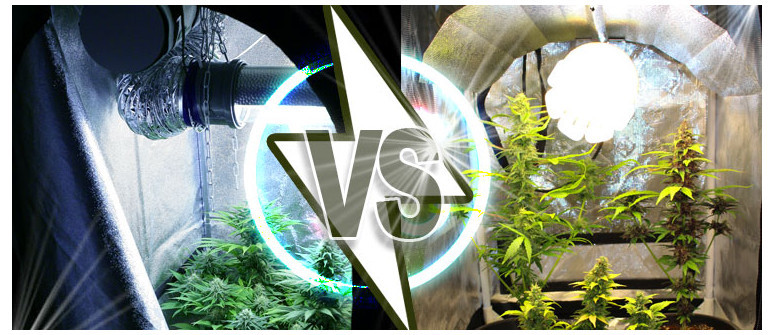
When growing indoors you will need one or more lamps above your cannabis plants. Shining a light is going to send beams of light in every direction including upwards. Light reflectors divert that wasted light back down to your plants, increasing light coverage and intensity.
Shining a light above your cannabis crop, regardless of how strong it is, is going to send beams of light in every direction. Some will undoubtedly reach your plants and fulfill their intended purpose. The beams that upwards, well, that's a lot of wasted energy and money. Light reflectors divert that wasted light back down to your plants, increasing light coverage and intensity. The result? You get better yields without wasting any of your already optimized lighting setups.
The complication comes from a vast array of light reflector designs, differing material and (in some cases) overinflated manufacturer proclamations. There isn't necessary any one definitive light reflector that is the best. The “best” option will depend entirely on your existing equipment and intended use, as well as your budget and the space you have available.
MORE LIGHT COULD MEAN MORE HEAT
Light will always travel in a straight line until it meets a surface it can bounce off of. In this case, that surface will hopefully be a light reflector. During the reflection, the surface it meets will absorb some of the light's energy, dispersing it in the form of heat. How reflective a surface is depends on how much of that energy is lost as heat.
Remember, we are trying to improve efficiency, so reflecting as many light rays as possible without any loss is our key objective. If the energy from light is lost to heat, rather than being reflected, all you will do is increase the temperature of your growing environment unnecessarily.
WHAT LIGHT REFLECTOR OPTIONS EXIST?
It would be impossible to list every single type of light reflector variation there is. Instead, we will list the most popular, categorized by how they are designed. The market has opened up tremendously, and as such, it is common for features to span differing models.
HOOD REFLECTORS
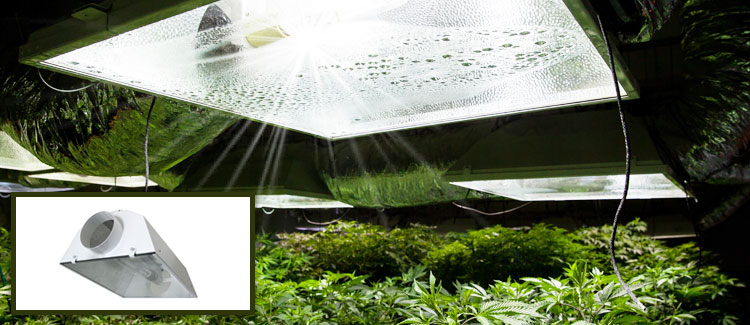
Shallow and wide or tall and narrow, there is a good chance a hood reflector will be more than suitable for the majority of growing environments. They can be tailored to the space available, and depending on how much light you want to reflect they can create concentrated areas for a select few plants or cast a wider beam of light, typically suitable for commercial operations.
They are considered to be so versatile because they come in a variety of shapes and sizes; however, the typically square shape of the reflector hoods gives a rather narrow reflective pattern, especially when compared to other types of light reflectors. With that in mind, you will need to think carefully about positioning to get the best bang for your buck.
UMBRELLA REFLECTORS
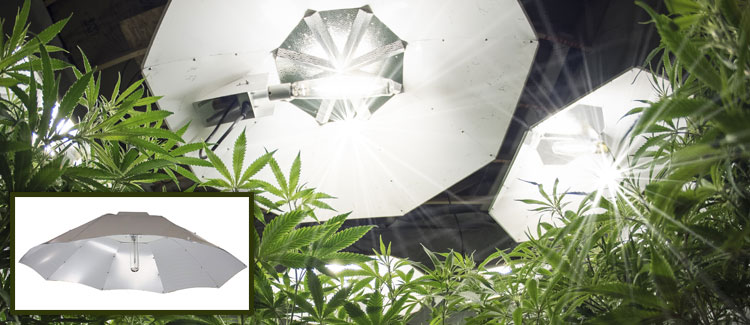
As the name suggests, umbrella reflectors offer a much larger footprint of light than the previously mentioned hood reflectors. For this reason, you would need less of them to cover the same area; however, their most significant benefit is also their largest downfall. The increased light coverage comes at the expense of light intensity. Light is dispersed over a wider area, but unless you decrease the distance between the top of your crop and the lights, light rays won’t penetrate much past the canopy roof.
The risk with lowering umbrella reflectors too far is that bulbs still generate a lot of heat. Even if you shell out for high-quality reflective material on your umbrella, placing the lights too close to cannabis plants may burn the leaves, damaging them. Umbrella reflectors also take up a lot of room so may not be viable for the majority of recreational or novice growers.
WING REFLECTORS
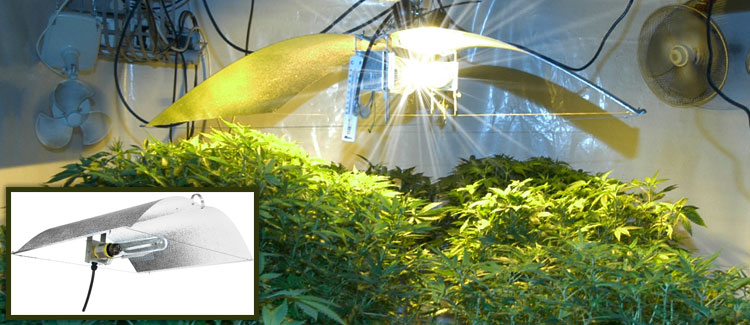
Wing reflectors would sit somewhere in the middle of both umbrella and hood reflectors. They offer a balanced, often adjustable, middle ground for light coverage and light intensity. Their diversity is also the reason for their widespread popularity. The wing reflects light in much the same way as the other types of reflectors do; however, the angled design means the light rays will hit multiple points and bounce back in various directions.
This angled bounce not only helps prevent hot spots but offers a fairly even spread of light intensity. When you compare cost versus light coverage, wing reflectors stand out as the winner in this respect. If you opt for an adjustable model, then light coverage can be altered as your plants develop to keep everything running smoothly.
Their jack of all trades approach is also part of the reason some growers avoid them. They do everything, but they do everything to an average level. You could get better light coverage with an umbrella reflector, and you could get better intensity with a tall, narrow hood reflector.
OPEN VERSUS AIR COOLED RELFECTORS
Regardless of the design type, all of the models listed have one thing in common: the issue of heat generated by the bulb. With open reflectors, any heat generated is circulated in your grow room and, depending on position, heating and potentially damaging the tops of cannabis plants.
The answer to this problem would be an air-cooled reflector. A reflector with air cooling encapsulates the bulb in its own contained "box" made of glass. Using ventilation, cold air is then passed over the bulb and vented out of the grow room. Doing so keeps heat generated by your bulbs out of your grow room while still allowing for improved light intensity/coverage.
AIR COOLED REFLECTORS TICK A LOT BOXES
Air cooled reflectors can be hung slightly closer to plants because the heat is contained. With the additional benefit of having features like a wing design or being hood-shaped, there is typically an air-cooled reflector solution to suit every grower.
Air cooled reflectors would be considered the premium option when it comes to reflecting light, however the significant reduction in heat while incorporating the design aspects of previously listed reflectors makes them a very appealing option. Given they can also be hung very close to the canopy roof for optimum light intensity, it's hard to think of a reason not to like them.
The most significant drawback is cost. Air cooled reflectors are more costly than a standard hood reflector, for example. And, given they need a constant flow of air, there will be additional setup costs and complications from the installation of fans and ventilation.
WHAT SEPARATES ONE REFLECTOR FROM ANOTHER?
Aside from design, one of the final things to consider with light reflectors is the material they are using to reflect light. Remember the transfer of energy from light to heat? The material you choose will have a direct impact on just how much heat your reflector generates.
REFLECTOR MATERIAL QUALITY
Refraction index is how much light is reflected. A surface with a refraction index of 50% would reflect 50% of the light, but the remaining 50% would be lost as heat. The cheapest option available in light reflectors is oxidized aluminum, which has a refraction index of roughly 70%. It isn’t awful, but it still creates a lot of lost energy and extra heat in your grow room.
Anodized aluminum represents a middle ground at 85% — better but still not the best. In the top spot, physical vapor deposition aluminum (PVD) has a refraction index of 95% — a substantial improvement on the cheapest option, oxidized aluminum. Besides regular maintenance and housekeeping, the efficiency of the material you choose will ultimately come down to cost. You will pay more for better quality reflective material.
SMOOTH OR BUMPY REFLECTOR TEXTURE?
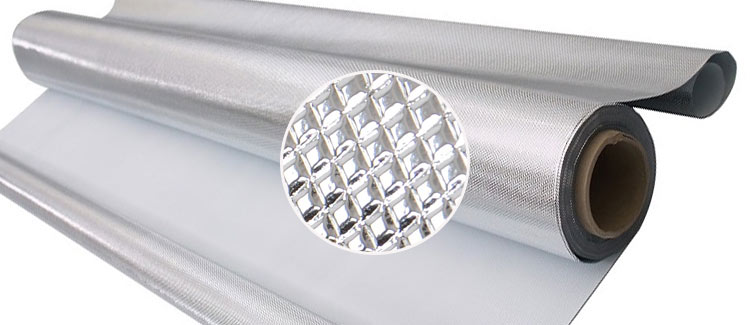
A final point on material attributes is texture. Smooth surfaces will reflect light beams in a straight line. Depending on the shape of the reflector this can create concentrated areas of light and hotspots. Wherever possible you want to avoid hotspots as again they may burn leaves and damage plants.
Dimpled aluminum surfaces will bounce the light in numerous directions, improving coverage and, depending on positioning, intensity as well. A smooth surface will require a carefully planned approach to location and will be less forgiving if you do not regularly review as plants grow. However, as you know that light is being bounced straight, it can also help you plan and finetune.
FINAL THOUGHTS: WHICH REFLECTOR IS RIGHT FOR YOU?
If we had a perfect checklist for the ultimate light reflector is would probably be an air-cooled umbrella hood with dimpled PVD. You would get the best of every world with that feature set, but and this is a very big but; what works for one grower may not work for everyone else.
Cannabis plants only need a source of light — they will grow without the use of a light reflector. However, if you want to get the most out of your plants and enjoy the dankest yields possible, get a reflector solution that matches your budget and your growing setup.




